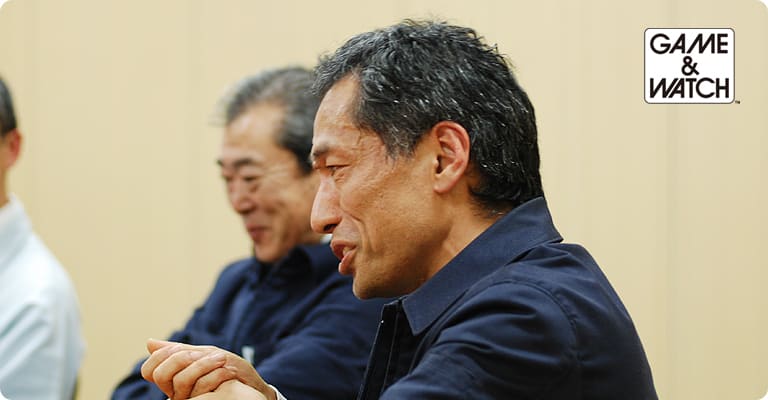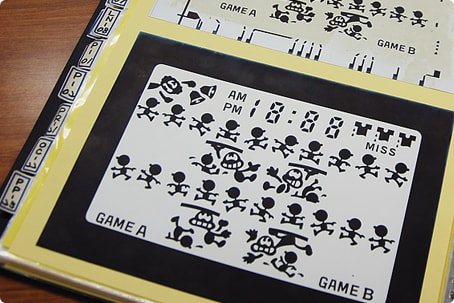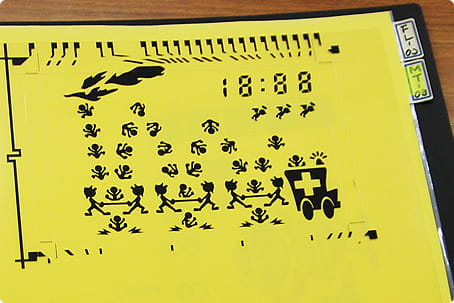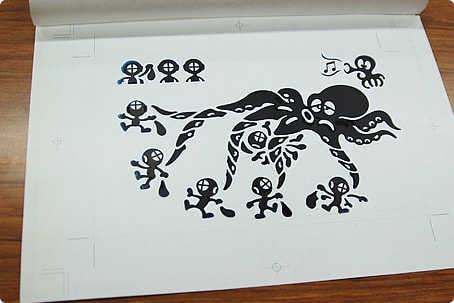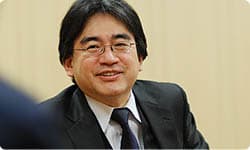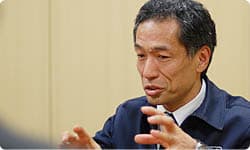Test Models with Little Bulbs
After an idea came together, what was the next step?
After we all brainstormed and the basic situation of the game had been determined, Yokoi-san would say, "The rest is up to you." (laughs)
By "you," he meant Kano-san. (laughs) Kano-san would redraw our clumsy drawings on the black board, and then it would look really interesting and we'd say, "Let's do it!"
(pulling out a folder) Actually, I've brought some old materials, too. These are some old drawings and other art we used back then.
Another amazing treasure! (laughs)
You still had this?!
It's so old the color is changing!
This was for the Game & Watch: Manhole game.
And there's Game & Watch: Fire.15
Here's Game & Watch: Octopus.16
This sure brings back memories!
We made the test models based on these illustrations.
15. Game & Watch: Fire: The fourth title in the Game & Watch series. Firemen had to use a sheet to catch people falling from a burning building. Released in July 1980.
16. Game & Watch: Octopus: The second Game & Watch game in the Wide Screen series. A diver had to avoid a giant octopus's legs as he retrieved a sunken treasure. Released in July 1981.
I heard that the test models were bigger than the actual systems and had lights. What was one like?
First, we took the materials that Kano-san had drawn up and put them on film in a darkroom.
In a darkroom? (laughs)
Yes. We made a reverse image of the original.
Then we used a jigsaw to cut acrylic plastic that was about five millimeters thick to match the pattern on the film and placed it onto a circuit board perfectly matching it in size.
Then we lined up grain of wheat bulbs17 at holes we had cut out.
Grain of wheat bulbs like used for plastic models? It truly is like craftwork! 17. Grain of wheat bulb: A small light bulb about the size of a grain of wheat. Grain of wheat bulbs are often used for the lights on model cars and trains.
It really was. And we had to be careful the light didn't bleed where it shouldn't.
We applied smoked acrylic so you could only see the graphics where the lamps were.
Rather than making software, most of the time it was like we were doing craftwork—cutting, gluing, and making holes.
You were like a bunch of mechanically-minded boys who got together to make big a Game & Watch system. How big were they?
About the same size as the original art we just saw, so about the size of an A4 piece of paper.
You made sure the game was fun by using big Game & Watch test models the size of an A4 piece of paper.
We'd run one and say, "We should change this a bit here," and "Let's make it easier to see here."
It was important that the movement look natural. If it didn't look right on the test model…
So you didn't just make the test model once?
No. And Yokoi-san would check it. We talked about the "Yokoi standard" back then. We could hardly get anything past him.
It was important throughout the entire Game & Watch series that when a player messed up, they realized the game wasn't being unfair.
They would think, "I'll try again!"
If a ball fell and the player was certain that he or she had caught it but the game said otherwise, it would be frustrating.
We decided to make it so that in situations where the players were likely to think they had caught it, the game would also recognize it as such. They hadn't caught it according to the signal, but we made the game's judgment a little loose.
You put some play into the calls it made.
Right. Timing is everything, so we retuned it over and over again. Then, when we were almost done, Yokoi-san would give us the most incredible tasks. He'd play the test model and say, "What if something came out right here and got in the player's way?"
But as of the time, we'd made a prototype, we already thought it was fine. Nonetheless, Yokoi-san would say, "Why not try it once more?"
He was always saying that.
But the staff couldn't tell whether that was good or bad. With great reluctance, we'd redo the visuals.
That was how upending the tea table began! (laughs)
Yeah! After the pattern had changed, once again we'd…
Back to the darkroom? (laughs)
Yeah. We'd start there again.
But when we'd done that…
It would be really great.
It would get much better.
It sounds hard, but also a little fun. (laughs)
It was fun.
Yeah, lots of fun.
How many months did it take you to make one title?
There were times when we made one per month.
Yamamoto-san and I would take turns developing the software, so we could put out one product a month.
That's incredible. Today's games are much more complicated, but we can punch a few buttons on the keyboard and try it out right away. It was different for the Game & Watch system. You'd have to go back to the darkroom and reassemble everything, so it must have been really hard. How did you handle the programming?
Izushi-san and I became significantly involved in the series with Game & Watch: Fire, which was the fourth game. At first, we didn't do programming, but made the game through the hardware.
In other words, you didn't write programs like you would today, but made the game run through circuit design.
Right. That's how we made Color TV Racing 112 and Color TV Game Block Breaker. Just by seeing the specifications for the game, we could imagine what the circuit should look like. So we used a soldering iron to make the prototype of Game & Watch: Fire.
Instead of a keyboard, a soldering iron. (laughs)
We thought that would be faster. And it was.
That's right.
But along the way, you started programming software?
Yes. We learned programming languages and started programming software. Then we thought, "This is much easier!" (laughs)
It's easier and much faster. (laughs)
It's faster and our hands don't get as dirty! (laughs)
(laughs)
